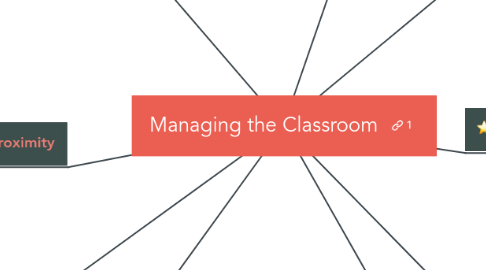
1. The teacher in the classroom
1.1. The way we move and stand, and the degree to which we are physically demonstrative can have a clear effect on the management of the class.
1.1.1. Most importantly, the way we are able to respond to what happens in class, the degree to which we are aware of what is going on, often marks the difference between successful teaching and less satisfactory lessons.
1.1.1.1. One of the main reasons why proximity control works
1.1.1.1.1. It is because students become hyperaware of the teacher’s presence and the implicit standard that presence demands of them.
2. Proximity
2.1. Teachers should be conscious of how close they are to their students, if necessary, modify their behavior.
2.1.1. Movement
2.1.1.1. Some teachers tend to spend most of their class time in one place – at the front of the class.
2.1.1.1.1. The teacher has to be careful every movement he/she made, because the students can get bored and exhausted.
3. Awareness
3.1. The teacher has to be aware of what students are doing and, where possible, how they are feeling
3.1.1. Awareness means assessing what students have said and responding appropriately.
3.1.1.1. This means being able to perceive the success or failure of what is taking place in the classroom, and being flexible enough to respond to what is going on.
4. Voice
4.1. Perhaps our most important instrument as teachers is our voice.
4.1.1. When considering the use of the voice in the management of teaching, there are three issues to think about:
4.1.1.1. Audibility
4.1.1.1.1. They must be sure that the students at the back of the class can hear them just as well as those at the front.
4.1.1.2. Variety
4.1.1.2.1. It is important for teachers to vary the quality of their voices
4.1.1.3. Conservation
4.1.1.3.1. It is important that teachers breathe correctly so that they don't strain their larynxes.
5. What is classroom management?
5.1. It is the way we handle a range of variables
5.1.1. For example:
5.1.1.1. Classroom space is organized
5.1.1.2. Classroom time is organized
5.1.1.3. The way we talk to students
5.1.1.4. Dealing with difficult situations
6. Appropriacy
6.1. It is the general way in which teachers sit or stand in classrooms.
6.1.1. All the positions teachers take make strong statements about the kind of person the teacher is.
7. Talking to students
7.1. The way that teachers talk to student and interact with them is one of the crucial teacher skills
7.1.1. It requires teachers to empathize with the people they are talking to by establishing a good rapport with them.
7.1.1.1. Teachers need to be aware of three things:
7.1.1.1.1. Consider the kind of language that students are likely to understand.
7.1.1.1.2. They need to think about what they wish to say to the students and how best to do it.
7.1.1.1.3. Consider the manner in which they will speak.
8. Giving instructions
8.1. The best activity in the world is a waste of time if the students don't understand what it is they are supposed to do.
8.1.1. There are two general rules for giving instructions:
8.1.1.1. They must be kept as simple as possible,
8.1.1.2. They must be logical
9. Student talk and teacher talk
9.1. Overuse of TTT is inappropriate because the more a teacher talks, the less chance there is for the students to practice their own speaking — and it is the students who need the practice, not the teacher
9.1.1. A good teacher maximizes STT(Student Talking Time) and minimizes TTT (Teacher Talking Time)
9.1.1.1. We should not talk simply about the difference between STT and TTT, but also consider TTQ (Teacher Talking Quality).
9.1.1.1.1. Teachers who engage students with their stories and interaction, using appropriate comprehensible input will be helping them to understand and acquire the language.
